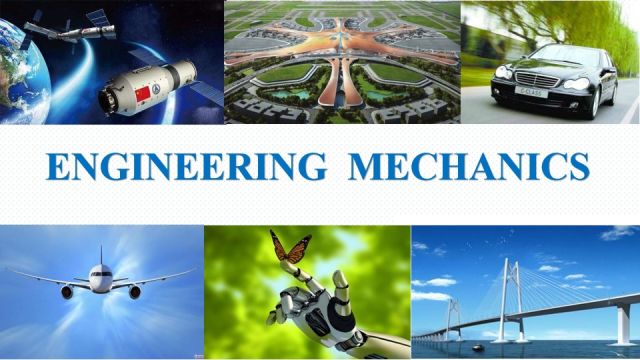课程介绍
Engineering mechanics is a professional basic course. It provides a necessary foundation for learning about the subsequent advanced professional courses. And it can be directly applied to solve many engineering problems in the field of aerospace, civil engineering, mechanical engineering, energy and power, etc.
This course introduces the fundamental concepts of mechanics, for example, force/rigid body/equilibrium/friction, stress/strain, strength/rigidity etc. It studies the statics firstly, and then this module develops concepts of stresses and strains in basic deformations and how they may be designed to provent failure. It deals with the strength conditions and rigidity conditions of components under tension/compression, shear, torsion and bending. It provide students with a clear and thorough presentation of the physical behaviour of materials under load and then modeling this behaviour to develop the theory.Corresponding applications for real-life design tasks are finally discussed to get insight into basic mechanics-based material selection criteria.
课程大纲
Chapter1 : Axioms of Statics and Freebody Diagram
1.1 Basic conception in statics
1.2 Axioms of statics
1.3 Constraints and their reaction forces
1.4 Force analysis and force diagrams
Ch1 Free body diagram
Chapter 2 : Coplanar Fundamental Force Systems
2.1 The graphical method of composition and the equilibrium of a coplanar system of concurrent forces
2.2 The analytical method of composition and the equilibrium of a coplanar system of concurrent forces
2.3 Force couples
Ch2 Fundmental Force system
Chapter 3: General Coplanar Force System
3.1 Moment of a Force about a Point
3.2 Reduction and Resultants of General Coplanar Force Systems
3.3 Equilibrium of a general coplanar force system
Ch 3: General Coplanar Force System
Chapter 4 Equilibrium of a Body System
4.1 The concepts of statically determinate and statically indeterminate problems,the equilibrium of a body system
4.2Analysis of internal force of plane truss
Ch4 Equilibrium of a Body System
Chapter 5 Friction
5.1 Types of Friction
5.2 Theory of Sliding Friction
5.3 Equilibrium problems with friction
Ch5 Friction
Chapter 6 Introduction to Mechanics of Materials
6.1 Tasks of Mechanics of Materials and basic assumptions of deformable bodies
6.2 Some Concepts
Chapter 6 Introduction to Mechanics of Materials
Chapter 7 Axial Tension and Compression
7.1 Axial force and stress
7.2 Properties of mechanics of materials of axially loaded members
7.3 Strength condition
7.4 Deformation of axially loaded bars · Stress concentration
Chapter 7 Axial Tension and Compression
Chapter 8 Shear
8.1 Introduction
8.2 Strength Calculation of connecting members
8.3 Pure shear and Hooke’s Law in Shear
Chapter 8 Shear
Chapter 9 Torsion
9.1 Internal Force and Internal force diagram
9.2 Torsional shear stress of circular shafts
9.3 Torsional deformation · Strength condition and rigidity condition
Chapter 9 Torsion
Chapter 10 Internal Forces in Bending
10.1 Internal forces in Planar Bending
10.2 Drawing of shear force and bending moment diagrams
10.3 Relations among load, shear force and bending moment
Chapter 10 Internal Forces in Bending
Appendix A Moments of Areas
A.1 Static moment of an area and centroid
A.2 Moment of inertia of an area · Product of inertia of an area · Radius of gyration
A.3 Parallel-axis theorem
Appendix A Moments of Areas
Chapter 11 Stresses in Bending
11.1 Normal stress in pure bending
11.2 Extension of normal stress formula · strength condition
11.3 Shear stress in transvers bending · Strength condition
11.4 Design of beams
Chapter 11 Stresses in Bending
Chapter 12 Deflection of Beams
12.1 Differential equation of the deflection curve
12.2 Double integration method
12.3 Method of superposition
12.4 Rigidity condition and Design of beams
Chapter 12 Deflection of Beams
学习目标
(1)Requires students to master the rigid body system balance and the equilibrium problems were analyzed and solved by the basic method;
(2)Require students to grasp the rod strength analysis and calculation of three kinds of engineering problems the basic method as well as the strength of the rational design of ideas;
(3)Require students to grasp the rod stiffness analysis and calculation of engineering problems of basic method as well as the stiffness of the rational design of ideas;
(4)Require students to grasp the rod stability analysis and calculation of engineering problems of the basic method and the stability of rational design thinking.
(5)Educate and guide students to form a correct world view,view of life and values.Strengthen students’ sense of social responsibility and mission.Set up students’ patriotism spirit and rigorous scientific spirit.Cultivate students to explore the unknown, truth and Innovative craftsman's spirit.
考核标准
The course adopts a variety of multiple assessment methods, and the course result is produced by the comprehensive assessment of the usual result and the final exam result.
Evaluation: quiz 30%, assignment 30 %, final exam 40%;
Usual Score is determined by quizzes and attendance rate;
Final Exam: closed book exam.
教材教参
1,R.C. Hibber,<Statics and Mechanics of materials> Pearson Education Inc. 2014.,2,Hibbler R C. Engineering Mechanics: Statics. 14th ed. Singapore: Pearson Prentice Hall, 2016




